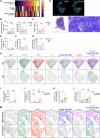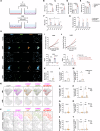Tumor cells that resist neutrophil anticancer cytotoxicity acquire a prometastatic and innate immune escape phenotype
- PMID: 40155451
- PMCID: PMC12041228
- DOI: 10.1038/s41423-025-01283-w
Tumor cells that resist neutrophil anticancer cytotoxicity acquire a prometastatic and innate immune escape phenotype
Abstract
In the tumor host, neutrophils may exhibit protumor or antitumor activity. It is hypothesized that in response to host-derived or therapy-induced factors, neutrophils adopt diverse functional states to ultimately execute these differential functions. Here, we provide an alternative scenario in which the response of an individual tumor cell population determines the overall protumor versus antitumor outcome of neutrophil‒tumor interactions. Experimentally, we show that human neutrophils, which are sequentially stimulated with bacteria and secreted factors from tumor cells, kill a certain proportion of tumor target cells. However, the majority of the tumor cells remained resistant to this neutrophil-mediated killing and underwent a functional, phenotypic and transcriptomic switch that was reminiscent of partial epithelial‒to-mesenchymal transition. This cell biological switch was associated with physical escape from NK-mediated killing and resulted in enhanced metastasis to the lymph nodes in a preclinical orthotopic mouse model. Mechanistically, we identified the antimicrobial neutrophil granule proteins neutrophil elastase (NE) and matrix metalloprotease-9 (MMP-9) as the molecular mediators of this functional switch. We validated these data in patients with head and neck cancer and identified bacterially colonized intratumoral niches that were enriched for mesenchymal tumor cells and neutrophils expressing NE and MMP-9. Our data reveal the parallel execution of tumor cytotoxic and prometastatic activity by activated neutrophils and identify NE and MMP-9 as mediators of lymph node metastasis. The identified mechanism explains the functional dichotomy of tumor-associated neutrophils at the level of the tumor target cell response and has implications for superinfected cancers and the dysbiotic tumor microenvironment.
Keywords: Staphylococcus aureus; Dysbiosis and oral microbiome; Epithelial‒mesenchymal transition; Lymphatic metastasis; Neutrophil extracellular traps; Tumor-associated neutrophils; neutrophil elastase.
© 2025. The Author(s).
Conflict of interest statement
Competing interests: SB declares research funds received by Roche/Genentech. These funds did not affect the work presented here. The other authors declare that they have no potential conflicts of interest.
Figures






References
-
- Coffelt SB, Wellenstein MD, de Visser KE. Neutrophils in cancer: neutral no more. Nat Rev Cancer. 2016;16:431–46. - PubMed
MeSH terms
Substances
Grants and funding
- n/a/Marga und Walter Boll-Stiftung (Marga and Walter Boll Foundation)
- BR2278/8-1/Deutsche Forschungsgemeinschaft (German Research Foundation)
- TRR 332 project A4/Deutsche Forschungsgemeinschaft (German Research Foundation)
- HU 2795/2-1/Deutsche Forschungsgemeinschaft (German Research Foundation)
- 70110380/Deutsche Krebshilfe (German Cancer Aid)
LinkOut - more resources
Full Text Sources
Medical
Miscellaneous

